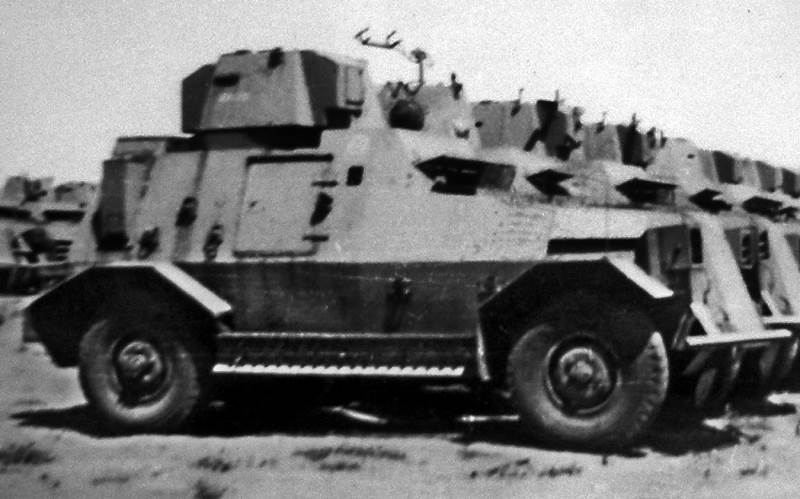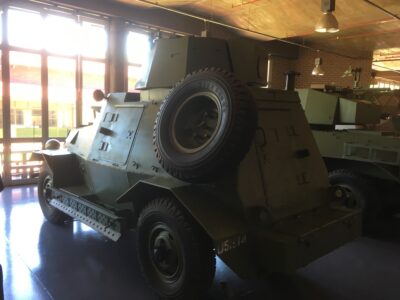With war clouds gathering in 1939 the Union of South Africa was forced to develop its own armoured cars. An armoured body was designed and developed in South Africa and mounted on the chassis of the Ford 3t General Service Truck. This was a normal rear wheel drive vehicle. This was designated South African Reconnaissance Car Mk I and starting in 1940 a total of 135 were produced.
From the beginning, the South African designers wanted to improve their armoured cars. They turned to the Ford Company of Canada to furnish a suitable chassis with right-hand steering. For a front axle that was driven and steered, they turned to the Marmon Herrington company.
The Marmon Herrington company had, from 1932, sold kits, that converted trucks to all-wheel drive vehicles. In this way the South African designers were able to upgrade their 2-wheel drive Ford 3t General Service Truck chassis to 4-wheel drive. At the same time, they also took the opportunity to improve the ground clearance. This improved car was known as the South African Reconnaissance car Mk II. A total of 887 of the Mk II were built up to June 1941.
Continuous development led to the South African Reconnaissance car Mk III of which 2630 were produced. The overwhelming majority of enthusiasts use the term Marmon Herrington to describe the full range of South African armoured cars.
We added two South African Reconnaissance Car Mk III Marmon-Herringtons to our collection in the Summer of 2018.
We are currently carrying out extensive research on the South African Reconnaissance car Mk III Marmon-Herrington, while we complete our current restoration project. This in-depth investigation will provide us with sufficient detail to assist us in identifying vital components. As with all of our projects, this information will help us obtain and manufacture or repair existing parts. One of the main sources of our early research is William Marshall and his excellent book The South African Reconnaissance Car.
Our research team established that there are two instrument panels, covering the Mk III both supplied by Ford. The Ford supplied panel for later (rear door) Mk III, was the Ford 1941 – 47 truck panel. However, a period photograph from the Ditsong Museum of Saxonwold in Johannesburg showed an instrument panel that was a blend of both the earlier Ford instrument panel for the Ford 1940 truck and the later Ford 1941 – 47 truck panel.
We have a complete chassis for the later SARC Mk III and the engine is a Ford flathead V8.
An initial report from our paint conservation partner Lincoln Conservation, proved to be an issue. The sample that we provided was from an area not exposed to the elements. However, the chemical analysis revealed that it was a modern polymer (possibly Alkyd), not used until after the war. Although Alkyd was developed during the war years, it was reputedly not used until after the war. Further analysis is needed, as it is unlikely that the vehicle’s paint would have been stripped back to the metal and repainted after the war.
We are delighted to share our latest estimates of assembly dates. The first of the Foundation’s South African Reconnaissance Car Mk III can now be revealed as being assembled in approximately October 1941. The second car was assembled circa May 1942, towards the end of production of the Mk III. This is great news at significant changes occurred during the production of such many armoured cars. It also must be remembered that there is a significant number of different South African firms engaged in final assembly. Therefore we are busy identifying features from each company.
The later May 1942 example has a large door in the rear armour, in addition to the side hatches, and to accommodate this the spare wheel is moved to the left side. Tow points are plates with circular holes cut there in.
Our other later Mk III (with rear door) only displayed one paint colour – “Union Defence Force Green”. We already have the analysis of this paint in hand and are, therefore, able to faithfully reproduce UDF Green as the project requires.
Most surviving Mk IIIs are mainly late examples with the rear door. A basic study of their paint treatment thus far has exposed only one base colour, UDF Green. Does this tell us something? It is dangerous to assume at this stage without the scientific results provided by our paint conservation, but something appears to be happening.
These late Mk III armoured cars were by this stage late in the cycle of assembly. They all are late examples which probably never left South Africa given the proximity of their identification numbers. Going by the archive information, the South African assembly of these important armoured cars had passed its peak and the Mk IV variant was now in the planning phase.
- This article has 792 words
- Reading time: 3 minutes
- There are no photos
Become a Member - Access the Full Article
Members gain access to the full content of our articles, including photo galleries.


